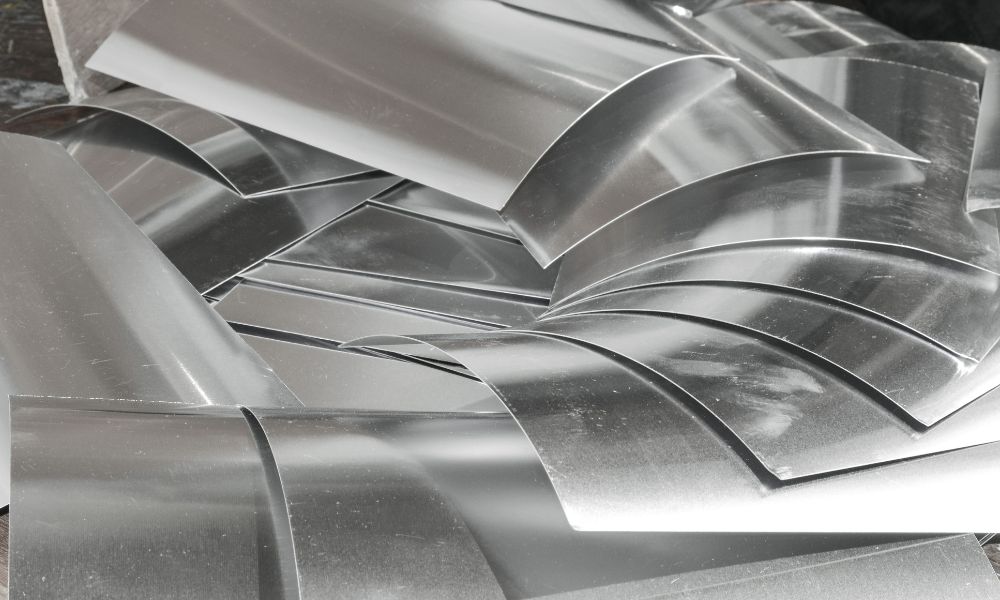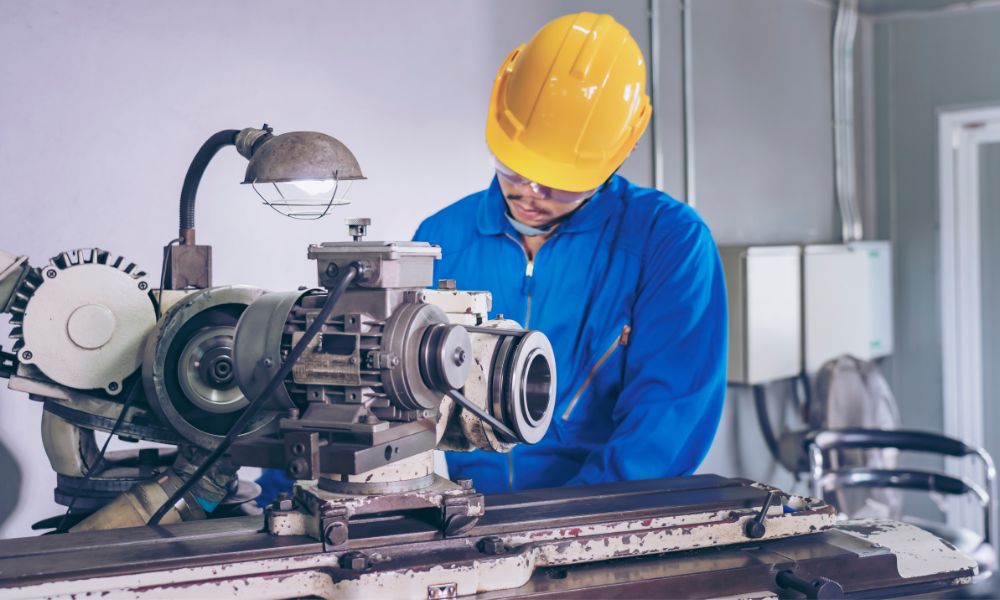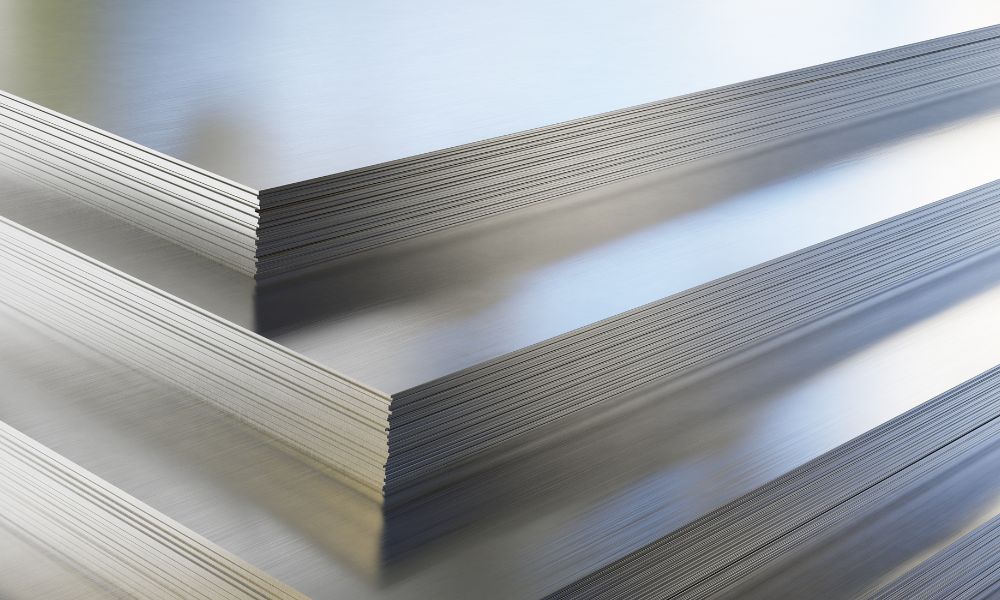- Home
- Browse Catalog and Order Now
- Ready to Ship Blanks
- Made to Order Blanks
- Aluminum & Steel Custom Vice Jaws
- Metal Services
- Materials
- Company
- News
- Contact Us
The metalworking industry, a pillar of modern manufacturing, is not immune to the pressing need for sustainability. As we face increasing environmental concerns, this industry must evolve to ensure less wastage, reduced energy consumption, and minimal environmental impact. Read on to discover five ways to improve sustainability in metalworking.
First and foremost, efficient resource management is key to sustainable metalworking. This management involves optimizing processes to reduce wastage and increase productivity. For instance, using high-precision machinery can minimize material waste and improve energy efficiency. Furthermore, recycling scrap metal can significantly reduce the need for raw materials, lowering the industry’s overall environmental footprint.
Switching to renewable energy sources can drastically reduce the environmental impact of metalworking operations. Solar, wind, and hydro energy can provide a significant portion of the power needed for metalworking facilities. The upfront investment in renewable energy infrastructure may be substantial, but the long-term benefits in cost savings and sustainability make it worthwhile.
Embracing modern technology can significantly improve sustainability in metalworking. Newer machinery and software are generally more efficient, leading to less energy consumption and waste. Additionally, advanced technologies like artificial intelligence and machine learning can optimize processes to improve efficiency, reduce environmental impact, and make it easier to produce finished parts.
Materials Sourcing Considerations
Taking a close look at your internal processes and understanding where you can improve efficiency and sustainability can make a big difference. For example, precision aluminum plates cut to size can help you reduce waste by eliminating scrap, eliminating in-house materials prep, and improving your shop's overall throughput by 25% or more.
Lastly, sustainability in metalworking isn’t just about machinery and processes—it’s also about people. Training employees on the importance of sustainability and teaching them sustainable practices can make a significant difference. Implementing sustainable practices becomes easier to do when everyone in the organization understands and values sustainability.
Now that you know five ways to improve sustainability in metalworking—efficient resource management, use of renewable energy, investing in modern technology, Materials Sourcing Considerations, and employee training—it’s time to put these strategies into action. Implementing these changes will not only benefit the environment but can also result in significant cost savings and enhanced operational efficiency. Sustainable metalworking is a win-win situation for everyone.

Stainless steel, a ubiquitous material in modern society, often raises intriguing questions. One such question is whether stainless steel is magnetic. The answer isn’t as straightforward as you might expect—here’s what you should know about whether stainless steel is magnetic.
The magnetic properties of stainless steel are determined by its composition. The two primary categories of stainless steel are austenitic and ferritic. Ferritic stainless steel, made primarily of iron and chromium, is inherently magnetic. On the other hand, austenitic stainless steel, comprised of iron, chromium, nickel, and other elements, generally lacks magnetic properties.
Beyond the type of stainless steel, the material’s manufacturing process can influence its magnetism. For instance, austenitic stainless steel can become partially magnetic if it undergoes a process called cold working, where the steel is shaped at room temperature. This process alters the composition of the steel, leading to an increase in magnetism.
The crystal structure of stainless steel can determine its magnetic properties. Austenitic stainless steel has a face-centered cubic crystal structure that generally renders it non-magnetic. On the other hand, ferritic stainless steel, with a body-centered cubic crystal structure, naturally exhibits magnetism.
Knowing whether stainless steel is magnetic is essential in many applications. For instance, in the food industry, magnetic stainless steel can be handy for removing metal contaminants from food products. You may also require stainless steel with no magnetic qualities, depending on the end use.
Compared to other metals, stainless steel—particularly austenitic stainless steel—has high corrosion resistance, making it preferable in environments that demand durability and longevity.
For specific applications, custom stainless steel blanks provide a solution tailored to your unique needs. Whether you require a certain level of magnetism or not, these blanks can be made with the precise type and grade of stainless steel that fits your requirements. They offer the flexibility of customization, allowing you to determine the dimensions, shape, and composition necessary, thus ensuring the desired magnetic properties for its intended use.
Now that you know whether stainless steel is magnetic and the factors that influence its magnetism, you’re better equipped to make informed decisions for your next project.

The time comes in every project when you need to move from development to production. However, you may not be sure which grinding method is best for your production needs—that’s where we come in. We’re here to share some of the services we offer and give you a better idea of what they entail.
This article discusses the differences between Blanchard and precision grinding and what you can expect from each method.
Like any cutting process, grinding reduces areas of the metal material that are unnecessary to the final product. At a glance, it makes sense to think of grinding as a version of trimming or shearing since the end goal is the same. However, grinding is a very different form of cutting than these other options.
While you can certainly consider grinding to be a type of cutting method, it is more commonly seen as a finishing method, as it is one of the most effective ways to hone metal parts to their intended dimensions. Grinding can also boost the surface quality of a product that has already been ground to the proper dimensions.
This process works by using a grinding wheel with an abrasive edge. The wheel turns at high speed and scrapes against the metal pieces until they reach the desired shape or finish.
While the world of metal grinding is vast, we’re going to look at two of the most common methods on the market: Blanchard and precision grinding. Blanchard grinding uses a rotating magnetic table and grinding wheel to remove large amounts of metal material from a surface.
Thanks to the magnetic table, the grinding wheel rotates rapidly while the metal you’re working on stays in place. Due to the circular motion of the grinding wheel, metal workers characterize Blanchard grinding by its unique cross-hatching pattern on the metal’s surface.
Most often, people seek out Blanchard grinding when they need a way to remove large amounts of material quickly, efficiently, and relatively accurately.
There are a few reasons to consider Blanchard grinding for your next project.
Blanchard grinding is a cost-effective solution for a variety of metalworking applications. It’s a grinding method known for producing quick results, meaning that you’ll save time and reduce labor costs compared to other grinding methods. On top of that, the machine’s large size makes cutting large parts easier—no need for multiple setups!
Blanchard grinding is also a method that allows you to grind a range of metal parts, from casings to forgings and weldments. Blanchard grinding can excel at the task, whether you need to grind flat surfaces or remove stock from a thick material.
In addition to those benefits, there are a few other factors to consider before selecting Blanchard grinding as your method of choice.
Traditionally, many see grinding as a precision job. While Blanchard grinding is not the least precise grinding method, it is certainly not the most, either. Blanchard grinding can be an excellent option for you if your tolerance is over 0.001 inches (or tolerance is a non-issue).
In addition, we previously mentioned Blanchard grinding’s characteristic cross-hatching pattern. In most cases, people seem to find this pattern to be aesthetically pleasing. However, if you are looking for metal that is blank and free from markings, Blanchard grinding may not be for you.
If Blanchard grinding is the go-to method for a quicker, rougher finish, precision grinding is the go-to method for the opposite: high accuracy finish on smaller parts. There are a few different types of precision grinding, from horizontal surface grinding to cylindrical grinding. Each of these methods falls into the “precision grinding” category and prioritizes accuracy above anything else.
Precision grinding works similarly to Blanchard grinding by using a wheel that grinds a metal surface down, but the tools used allow for much greater accuracy than Blanchard grinding. In addition, precision grinding produces a smooth surface with no patterns, burrs, or bumps.
Why should you consider precision grinding for your project? Here are a few reasons:
As the name suggests, this grinding method is precise. This level of accuracy is probably the single greatest reason that anyone chooses to use precision grinding on a project—they’re looking for intricate shapes or tight tolerances. The smaller your final parts are, the more you’ll want to turn toward precision grinding for your finishing needs.
On top of that, you can rely on precision grinding to produce a smooth finish, unlike Blanchard grinding. This smoothness makes finishing your product with a paint or powder coating much easier.
Just as there are a few things to keep in mind for Blanchard grinding, here are some potential drawbacks to precision grinding you should be aware of:
It’s best to use the precision grinding technique when working on a small scale, making it a less-than-ideal solution for larger pieces of material. Think about whether you’re planning to shear off significant chunks of metal—if you are, Blanchard grinding may be the more efficient choice for you.
Finally, it’s important to note that, compared to Blanchard grinding, precision grinding is much slower. Its slow speed allows for greater precision and a higher level of accuracy, but it is certainly something to consider if your project requires fast results. If you would prefer speed over accuracy, you might want to choose Blanchard grinding.
When you find yourself in need of metal services, whether they involve Blanchard or precision grinding (or another service entirely), you can count on TCI Precision Metals for assistance!
Now that you understand the differences between Blanchard and precision grinding, we hope you can see that each option has its optimal use case. Whether your products require Blanchard or precision grinding, the team here at TCI Precision Metals can help. If you’re looking for excellent results and top-tier customer service, you’re in the right place!
Metals form the backbone of modern society and play essential roles in various industries. If you’re curious to learn more about how we use metals in the world around you every day, you’ve come to the right place. Read on to learn some of the most common types of metals and their applications.
Copper is a metal that boasts superior electrical conductivity, so it’s no wonder it has become the preferred choice for electrical wiring and cable manufacturing. Copper is also an essential component in many electronic devices and equipment.
But that’s not all—this metal has antimicrobial properties, making it a popular choice for doorknobs, handrails, and other high-touch surfaces. Additionally, plumbing and roofing applications have made use of copper for centuries, proving that its versatility goes beyond its conductive prowess.
Iron is one of the most abundant elements on Earth, and it has played a crucial role in civilization’s development. From the building of massive structures like bridges and skyscrapers to the production of various machinery and tools, iron is a real workhorse.
Its popularity is due to its high tensile strength and relatively low cost. With the advent of steel (an alloy of iron and carbon), the importance of iron in modern society has only grown.
As we mentioned, steel is an alloy of iron and carbon and a force to be reckoned with. Its unique properties—such as high tensile strength, ductility, and resistance to corrosion—make it an indispensable material in various industries.
From automotive manufacturing to household appliances and cutlery production, steel has truly become a staple in modern life. Thanks to its recyclable nature, steel is also a more environmentally friendly option for many applications.
Humans have treasured gold for thousands of years, but its applications extend far beyond jewelry and currency. Gold is an excellent conductor of electricity, so we often use it in electronics like connectors and printed circuit boards.
Dentistry also uses gold, owing to its biocompatibility and malleability. Moreover, gold’s reflective properties make it a valuable component in satellite and space exploration technologies.
Silver is another precious metal with a myriad of applications. Like gold, silver is an excellent conductor of electricity, so electrical contacts and conductors use it. Its antimicrobial properties have led to its use in medical equipment and wound dressings. Additionally, silver’s lustrous appearance and malleability make it a popular choice for jewelry, tableware, and decorative items.
Platinum is a rare, precious metal that possesses numerous unique properties. Its high melting point and resistance to corrosion make it ideal for high-temperature applications and harsh environments. The automotive and chemical industries widely use platinum as a catalyst, as it plays a crucial role in reducing harmful emissions and speeding up chemical reactions. Additionally, its rarity and durability make it a sought-after material for high-end jewelry and watches.
Titanium is a metal known for its exceptional strength, low density, and corrosion resistance. It has an unmatched strength-to-weight ratio, making it a popular choice for aerospace, automotive, and military applications. In the medical field, titanium’s biocompatibility is perfect for implants, such as artificial joints and dental implants. On top of that, its resistance to corrosion makes it an attractive option for outdoor and marine applications.
Nickel is a versatile metal that excels in resisting corrosion, making it a valuable component in various alloys. One of its most well-known applications is in the production of stainless steel, as it significantly enhances the steel’s corrosion resistance.
Additionally, rechargeable batteries use nickel, making it a vital component for the rapidly growing electric vehicle and renewable energy industries. Its magnetic properties also make it useful in electronics and computer hardware.
Zinc may not be the flashiest metal on this list, but it plays an essential role in protecting other metals from corrosion. One of its most significant applications is in the process of galvanization, where manufacturers apply a thin layer of zinc to steel or iron to prevent rusting.
Zinc is also a vital component in various alloys, such as brass (a copper-zinc alloy) and die casting alloys. In addition, zinc’s biocompatibility and nontoxic nature make it a popular choice for nutritional supplements and pharmaceutical products.
Lead is a dense, soft, and malleable metal that humans have used for thousands of years. Its high density makes it an excellent material for radiation shielding, such as in X-ray machines and nuclear reactors.
Lead is also useful in the production of batteries, particularly lead-acid batteries for vehicles. However, due to concerns about its toxicity, lead’s role in plumbing and household products has greatly reduced, with safer alternatives taking its place.
Aluminum is a lightweight and versatile metal that the transportation, aerospace, and construction industries widely use. Thanks to its high strength-to-weight ratio, it’s the go-to metal for constructing airplanes, cars, and even bicycles.
Aluminum is also a popular choice for packaging, such as cans and foil, due to its excellent corrosion resistance and ease of recycling. Its nontoxic nature also makes it suitable for kitchen utensils and appliances. Truly, aluminum is a jack-of-all-trades in the world of metals—if you need custom aluminum plates, TCI Precision Metals has you covered.
Tungsten is a metal that boasts an extremely high melting point, making it perfect for high-temperature applications. Filaments for incandescent light bulbs and heating elements for electric furnaces are two common uses of this metal.
Tungsten’s hardness also makes it a popular choice for cutting tools, such as drill bits and milling cutters. In addition, the metal’s density and strength lend themselves well to applications in the aerospace and military industries, where durability and heat resistance are of utmost importance.
Magnesium is a lightweight metal with a variety of applications, particularly in the automotive and aerospace industries. Its low density and high strength-to-weight ratio make it an attractive option for reducing the weight of vehicles and aircraft, leading to improved fuel efficiency and performance.
Magnesium also plays a role in the production of alloys, combining with other metals to enhance their properties. Furthermore, its biocompatibility allows for its use in medical applications, such as bone implants and surgical instruments.
Now that you know these common types of metal and their applications, we hope you have a greater appreciation for how much the world runs on these materials.

Aluminum is a versatile, lightweight, and corrosion-resistant material, making it a popular choice for various applications. When working with aluminum, you should consider its two primary forms: aluminum sheet and aluminum plate. Read on to find out what you should know about aluminum sheet and aluminum plate.
The primary distinction between aluminum sheet and aluminum plate lies in the thickness. Aluminum sheet is thinner, typically ranging from 0.008 inches (0.2 mm) to 0.25 inches (6.35 mm) in thickness. On the other hand, aluminum plate is thicker, generally starting at 0.25 inches (6.35 mm) and extending up to 6 inches (150 mm) or more.
Due to the differences in thickness, aluminum sheets and plates have different applications. You’ll find aluminum sheet used in:
Meanwhile, you can find aluminum plate in:
When you need to pick between sheets and plates for your machine-ready blanks, start with a clear understanding of your project. If it requires a lighter weight or lower cost, aluminum sheets are likely better for it. Conversely, a project that calls for higher strength or greater thickness probably calls for aluminum plates.
Now that you understand what you should know about aluminum sheet and aluminum plate, we hope you have a better sense of the materials you need to complete your projects efficiently. You can always rely on the team at TCI Precision Metals if you need more help—just reach out!